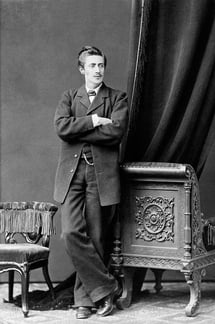The Nobel committee is known for its “prize motivation” citations when it awards its coveted Prizes each year. We hear these short snippets in articles and press releases about each winner, and they serve their purpose well: they are brief snapshots of why the winner won. While Nobel Prize in Literature winners are chosen based on the entire body of their work, in some cases, the committee cites a specific example. For example, in 1954 when Ernest Hemingway won, the committee said it was “for his mastery of the art of narrative, most recently demonstrated in The Old Man and the Sea…” On the opposite end of the spectrum, sometimes the prize motivation is much, much more over-arching. Case in point: when Carl Gustaf Verner von Heidenstam won the Nobel Prize in Literature in 1916, the Nobel committee said he was awarded “in recognition of his significance as the leading representative of a new era in our literature.” This is certainly high praise, but also quite general. Who was Verner von Heidenstam? What did he write, and how did he lead us into a new era of literature?
Who Was Verner von Heidenstam?
 Verner von Heidenstam was born in 1859 in Sweden to a noble family. While he initially wanted to be a painter, he turned his attention fully to poetry and became one of the most prominent Swedish poets in the late nineteenth and early twentieth centuries. His station in life allowed him the opportunity to travel, and an article in The Nation, published in 1916 shortly after the announcement of his Nobel win, cites his travels to the Orient and Italy as inspiration for his first volume of poetry, Vallfart och vandringsår, or Pilgrimage: The Wander year, which was published in 1888.
Verner von Heidenstam was born in 1859 in Sweden to a noble family. While he initially wanted to be a painter, he turned his attention fully to poetry and became one of the most prominent Swedish poets in the late nineteenth and early twentieth centuries. His station in life allowed him the opportunity to travel, and an article in The Nation, published in 1916 shortly after the announcement of his Nobel win, cites his travels to the Orient and Italy as inspiration for his first volume of poetry, Vallfart och vandringsår, or Pilgrimage: The Wander year, which was published in 1888.
Right from the start, Verner von Heidenstam’s poetry was significant in Sweden.
A Shift Away From Realism
According to Swedish critic Sven Söderman in his presentation of the 1916 Nobel Prize, Verner Von Heidenstam’s Pilgrimage: The Wander Years “marked an epoch in the modern literature of Sweden. In truth it gave the final blow to the realistic school, enemy of all imagination, which was then dominant in Sweden and which since 1880 had darkened literature with its sadness and its gloom. This was the first manifestation of a new poetry in which free individuals, led only by the logic of their imagination, worshipped beauty for its own sake."
Söderman’s analysis gives us insight into the general nature of his Nobel Prize motivation: Verner von Heidenstam led the charge for this “new era” of poets in his shift away from realism and his focus on “beauty for its own sake.” Indeed, much of Verner von Heidenstam’s work is introspective. His poem “Thoughts in Solitude” is a prime example:
There is a spark dwells deep within my soul.
To get it out into the daylight's glow
Is my life's aim both first and last, the whole.It slips away, it burns and tortures me.
That little spark is all the wealth I know;
That little spark is my life's misery.
A Swedish Patriot
 A trademark of Verner von Heidenstam’s later work is his Swedish patriotism. Whereas he could be incredibly focused on the self in much of his poetry, he also had a keen ability to bring together what he saw as the good in his home nation, writing verse that bubbles over with patriotic sentiment. He looks to the past and documents Swedish history and historical figures through his poems like Heliga Birgittas pilgrimsfärd (1901) [Saint Bridget's Pilgrimage] and Karolinerna (1897-98) [The Charles Men]. And in one of our favorite efforts by Verner von Heidenstam, he demands of the Swedish people of his day, saying in Ett folk (1902) [One People], “No people may be greater than you; that is the goal, no matter what the cost.”
A trademark of Verner von Heidenstam’s later work is his Swedish patriotism. Whereas he could be incredibly focused on the self in much of his poetry, he also had a keen ability to bring together what he saw as the good in his home nation, writing verse that bubbles over with patriotic sentiment. He looks to the past and documents Swedish history and historical figures through his poems like Heliga Birgittas pilgrimsfärd (1901) [Saint Bridget's Pilgrimage] and Karolinerna (1897-98) [The Charles Men]. And in one of our favorite efforts by Verner von Heidenstam, he demands of the Swedish people of his day, saying in Ett folk (1902) [One People], “No people may be greater than you; that is the goal, no matter what the cost.”
Reading and Collecting Verner von Heidenstam
Verner von Heidenstam is an intriguing poet, to be sure. We hope that by fleshing out his Nobel prize motivation, we’ve piqued your interest. If you’d like to read more of this Swedish Nobel laureate, we’d point your attention to his collected works, which were published in 23 volumes between 1943-1945. For the interested collector, we've seen volumes of Verner von Heidenstam's notable works floating around the marketplace for a range of prices, from $100 to several hundred dollars. As always, we recommend researching and consulting a trusted source for bibliographic information regarding edition and translation.
Sources: nobelprize.org, unz.org









